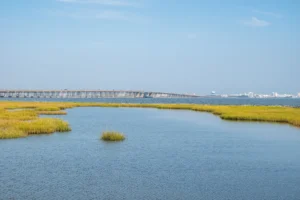Blue crabs are one of the Chesapeake Bay area’s most recognizable figures.
Maryland Blue Crabs
All About this Quintessential Coastal Crustacean
Every summer, visitors flock to Ocean City for sun, sand and delicious eats. Summers in Maryland, especially on the coast, aren’t complete without cracking a bushel of our famous blue crabs. Whether you enjoy them topped with Old Bay or served as a fried soft shell, you’ll definitely want to get your fix of this succulent delicacy after learning more about the Maryland blue crab.
Blue crabs are one of the Chesapeake Bay area’s most recognizable figures. While Maryland lays claim to the blue crab, these crustaceans are international. They can be found as far north as Nova Scotia and as far south as Argentina. Blue crabs, Callinectes sapidus, get their name from the bright blue color on their front claws, while the upper shell is usually an olive or blue-green color.
Get to Know Your Crabs
Male and female crabs, also known as a jimmies and sooks, respectively, can be distinguished two ways. Females have red tips on their front claws while males do not. You can also tell by the apron, or underbelly, of the crab. The male’s apron resembles an inverted “T” shape, while a female’s changes and rounds as it matures. Male and female blue crabs can also be found in different parts of the water. According to the Maryland Department of Natural Resources (DNR), males are often found in the upper reaches of the bay while females are typically found downstream, where salinities are higher.

The best time of year for catching blue crabs is from April to November. During the off season, when the weather cools down, many restaurants serve flash frozen Maryland blue crabs or Maryland-style blue crabs from other states.
Once you have your bushel of crabs, you have many different ways to utilize the meat. You can take lump crab meat and make a classic Maryland crab cake or creamy crab dip and crab soup. The most common way to serve Maryland crabs that truly encompasses the spirit is summer is a way that’s unique to the state. What differentiates Maryland from the rest of the country, when it comes to cooking crabs, is that we steam our crabs as opposed to boiling them. This can be done at home before a backyard feast or you can leave it to the professionals at a local restaurant or seafood market.
Crab pricing depends on two factors—the size and the market demand.
The Bigger the Better
The larger the crab, the more expensive and usually the tastier. When you order a bushel of crabs, you’ll want to make sure you pick one that’s full of lump crab meat. Male crabs tend to be meatier than females, but females are rumored to taste sweeter. Keep this in mind as you select your crabs. As you grab each crab, feel out the heavier ones. The heavier the crab, the more crab meat.
Tide-to-Table Effects
Crabbing can be a very profitable industry on Maryland’s coast after a plentiful reproductive season. However, in 2018, cold temperatures in the spring months led to a 35-percent decrease in adult female blue crabs, delaying the start of the harvest, according to the Maryland DNR. The cold weather caused a decrease in the overall blue crab population in the Chesapeake Bay, leading to a higher market demand.
When you buy crabs, and other seafood, at a local restaurant or market, they’ll often list the price as “M.P.” This stands for market price. If there is a higher demand for crabs during that season, the price will be higher.
Let’s Get Cracking
Once you’ve got your crabs, generously seasoned with Old Bay, lay out the newspaper and start cracking.






















